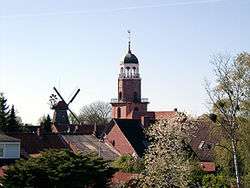Jemgum
| Jemgum | |||
|---|---|---|---|
|
The church and windmill of Ditzum in Jemgum municipality | |||
| |||
 Jemgum | |||
Location of Jemgum within Leer district 
 | |||
| Coordinates: 53°15′57″N 07°23′06″E / 53.26583°N 7.38500°ECoordinates: 53°15′57″N 07°23′06″E / 53.26583°N 7.38500°E | |||
| Country | Germany | ||
| State | Lower Saxony | ||
| District | Leer | ||
| Government | |||
| • Mayor | Hans-Peter Heikens (Ind.) | ||
| Area | |||
| • Total | 78.48 km2 (30.30 sq mi) | ||
| Population (2015-12-31)[1] | |||
| • Total | 3,539 | ||
| • Density | 45/km2 (120/sq mi) | ||
| Time zone | CET/CEST (UTC+1/+2) | ||
| Postal codes | 26844 | ||
| Dialling codes | 0 49 58 | ||
| Vehicle registration | LER | ||
| Website | www.jemgum.de | ||
Jemgum is a municipality in the Leer district, in the northwest of Lower Saxony, Germany. The area is known as Rheiderland (German) or Reiderland (Dutch). The Rheiderland is located in East Friesland. The East Friesland area of Germany (also known in English as East Frisia) is home to German writers Georg Klein (Bunde) and Uwe Kreisel (Jemgum). [[Image:|thumb| left|350 px]]
History
Jemgum was the site of the Battle of Jemmingen on 21 July 1568, an early event of the Eighty Years' War, in which a Spanish army defeated a Dutch Rebel army under Louis of Nassau.
References
This article is issued from Wikipedia - version of the 12/3/2016. The text is available under the Creative Commons Attribution/Share Alike but additional terms may apply for the media files.


